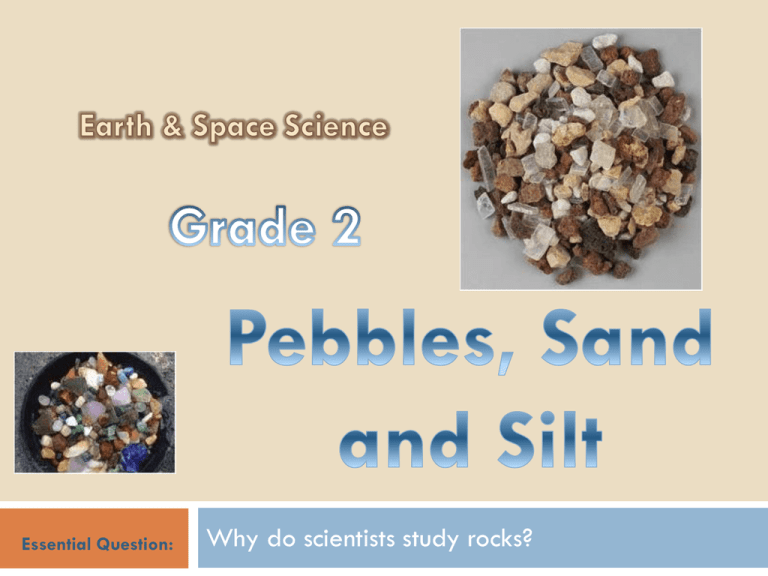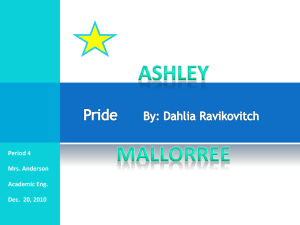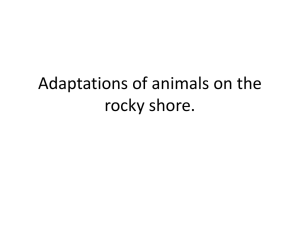File - Mrs. Lacerda
advertisement

Essential Question: Why do scientists study rocks? Earth & Space Science Statement of enduring knowledge: The earth and earth materials as we know them today have developed over long periods of time, through continual change and processes. Earth & Space Science Assessment Target: (K-4) Given certain earth materials (soils, rocks or minerals) use physical properties to sort, classify, and describe them. GSE’s – Earth & Space Science ESS1 (K-2)–1 Students demonstrate an understanding of earth materials by … 1a describing, comparing, and sorting rocks and soils by similar or different physical properties (e.g., size, shape, color, texture, smell, weight). 1b recording observations/data about physical properties. 1c using attributes of properties to state why objects are grouped together (e.g., rocks that are shiny or not shiny). GEOLOGIST A geologist is a SCIENTIST who studies the earth and earth materials such as rocks. Let’s see what kinds of things we can find out from taking a close look at rocks and other earth materials in this unit. Examine the three rocks… •Color? •Size? •Shape? •Texture? GEOLOGIST Volcanoes…. River More River Rocks… Even Bigger Rocks…. Essential Question: Why do people collect rocks? Remember doing this? Essential Question: What is the importance of rocks in our everyday lives? How could we live without rocks? Using Rocks… Statues Houses Roads Bridges Soil Explorations… What’s in dirt? Are all soils the same? How do soils differ? How are these soils different? Do you have an answer for these questions? Why do scientists study rocks? Why do people collect rocks? What is the importance of rocks in our everyday lives? Remember this? Statement of enduring knowledge: The earth and earth materials as we know them today have developed over long periods of time, through continual change and processes. And this… ? ESS1 (K-2)–1 Students demonstrate an understanding of earth materials by … 1a describing, comparing, and sorting rocks and soils by similar or different physical properties (e.g., size, shape, color, texture, smell, weight). 1b recording observations/data about physical properties. 1c using attributes of properties to state why objects are grouped together (e.g., rocks that are shiny or not shiny). And how about this one? Assessment Target: (K-4) Given certain earth materials (soils, rocks or minerals) use physical properties to sort, classify, and describe them. Our Unit… •Students will investigate rocks and other earth materials (sand, silt, clay, soil). •Students will conduct experiments. •Students will sort and classify earth materials by looking at their physical properties and attributes. •Students will keep scientist journals to record predictions, observations, and claims and evidence. PowerPoint •Students will create a PowerPoint presentation slide with a partner that demonstrates some of the new learning acquired as result of this unit. •Students will use Wordle.net to share and record (in a fun way) some words learned in rock classification and sorting. www.wordle.net Sample Scientist Journal Checklist & Rubric Scientist Journal Rubric Expert Practitioner Apprentice Novice 4 Outstanding All 6 Areas Checked 3 Good 4-5 Areas Checked 2 Making Progress 3 Areas Checked 1 Encountering Difficulty 2 or Less Areas Checked Criteria Checklist for PowerPoint Project Criteria Checklist for PowerPoint Project PowerPoint Slide Must Haves… PowerPoint Slide Must Haves… One image Four sentences about things learned …one from each of the Investigations on the different earth materials: 1. First Rocks 2. River Rocks 3. Using Rocks Soil Explorations Answer one of the Essential Questions: 1. Why do scientists study rocks? 2. Why do people collect rocks? 3. What is the importance of rocks in our everyday lives?









